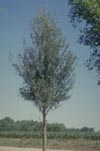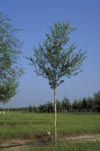Home >
Quercus virginiana Highrise™, Highrise™ Oak
Best growth is made in moist, acid soil, sand, loam or clay, but the tree is amazingly adapted to drought. It also tolerates alkaline soil well. Construction-impacted trees take a long time to die, giving Live Oak a reputation for being a tough tree. Once established, Live Oak will thrive in almost any location and has very good wind resistance. Live Oak is a tough, enduring tree that will respond with vigorous growth to plentiful moisture on well-drained soil. Trees compartmentalize decay very well but they are not immune to decay.
Like other Oaks, care must be taken to develop a strong branch structure early in the life of the tree. However, this cultivar may be easier to prune into a central, dominant leader than is the species. Regularly reduce the length of upright stems to ensure that branches and stems remain less than about half the trunk diameter. Quercus fusiformis is native to central and southern Texas, is perhaps more adapted to Texas than Quercus virginiana but nursery operators do not normally differentiate among these. Q. geminata (Sand Live Oak) is more salt tolerant than Live Oak. Live oak is now planted in California.
This is the first, well known, named cultivar of Live Oak propagated from cuttings. They grow to a two- or three-inch caliper tree at about the same rate as the species. Young plants (those up to at least seven inches in trunk caliper) are upright with a strong central leader and a canopy much taller than wide. This makes them good candidates for street trees (parent tree was 22 feet tall x 7 feet wide). The ultimate shape of the tree is unknown; my guess is that it will eventually take on an oval to rounded canopy. Young plants have more upright branches than most seedlings and, unlike seedlings, all plants look very much alike. It is quite a site to behold a field of live oaks that all look alike! I can't wait to see a street lined with Highrise Live Oak.
Many of the branches form a 'U' shaped crotch; however, like the species, some crotches form included bark. Recent research indicates Highrise forms included bark at the same rate as the species. Trees require about the same time to prune as seedlings, at least in the first three years after planting in the nursery from liners. Less than one percent of the Highrise trees required staking in the nursery to create a central trunk; whereas up to 30 percent of seedlings required stakes and splints.
Oak
wood is considered ring porous to semi-ring porous. Plant serves as host
for White M. Hairstreak (Parrhasius m-album) butterfly larvae and
the brown duskywing butterfly (Erynnis horatius).




